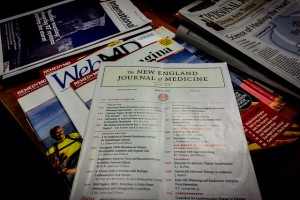We’re onto the third post in our series on positive thinking. The first post looked at where the modern positive thinking movement came from, and the second saw the movement expand into the research laboratory and onto the public’s bookshelves. Today we’ll chat about how the medical community finally took interest in positive thinking as a healing tool and how this curiosity became a seductive message in our collective consciousness.
Part 3
Laughable
The medical community was more concerned with pathology than they were with psychology. They were connecting asthma to allergens and ulcers to bacteria. They didn’t buy into the idea that your traumatic childhood and repressed desires could create illness – that is until 1976 when an article appeared in the New England Journal of Medicine.
It was written by Norman Cousins who was a political analyst and the editor of the Sunday Review – decidedly not a doctor. Cousins was writing about his personal healing experience. He was diagnosed with a degenerative disorder that was breaking down the collagen between his cells, a very necessary part of life. His doctors had little to offer for treatment and gave him a 1 in 500 chance of recovery, odds no one wants to hear. Standing at a dead end, Cousins started looking at other research that could provide some hope and started reading about Walter Cannon’s work with stress at Harvard.
He wondered – if negative emotions have a negative impact on body chemistry, what about positive emotions? Could those heal? Cousins designed a personal experiment, checked himself out of the hospital and prescribed large doses of laughter. He watched Marx Brothers’ movies and episodes of Candid Camera while taking high doses of vitamin C. After a few months he was in total remission: back to work, on vacation, illness gone.
It was the prestige of the New England Journal of Medicine which lent credibility to Cousins’ story and prompted the medical community’s curiosity about the mind-body connection. Each year from the publication of Cousin’s miraculous healing the number of experiments looking at the mind-body connection have increased exponentially.
Researchers looked to connect a type A personality with heart disease and asked about the connection between hopelessness and cancer. They thoroughly investigated the placebo effect. Ultimately, the question on everyone’s mind was asked: is love the cure-all?
Some of this research was having real success and getting picked up by mainstream media outlets which distributed these ideas far and wide. Like Oprah wide.
Sticky Beliefs
From the firestorm of research and discussion about the mind-body connection, society came away with three sticky beliefs firmly ingrained in our collective consciousness. Those are:
- The body sends messages about our conscious (or unconscious) thoughts and emotions. It is as if our physical symptoms are weathervanes for which way the wind is blowing our emotions. A backache is no longer just a backache; it is a message about your stress level.
- Negative thoughts and emotions manifest and illness. Plus the flip side, positive thoughts can do more than just improve health, they can cure you.
- These first two beliefs combine together to send the subtler message that we alone are responsible for the our health (or lack thereof).

photo credit: Nina Matthews Photography via photopin cc
An Enticing Message
It is completely frustrating to receive a diagnosis and be told that there is little that can be done to cure you. It is beyond hard to hear that your condition is chronic. There is a distinct sense of betrayal, as if your body has gone rogue and is refusing to listen to your commands. The lack of control is palpable.
You will continually ask your medical team how to change your fate. Diet? Exercise? Medication? You’ll hear that some of those may help or offer reprieve, but not a final solution.
We all want control and these spiritual leaders and researches have told us that we have that within. A divine spark. A central nervous system. Neural connections. An immune system. If we get a cut our body automatically knows how to heal itself.
This plays perfectly into the psyche of a patient because it answers that illusive “why” question. Why am I sick? Because you’re stress, having trouble in your relationship, took on too much at work. And it offers the solution. Want to get better? Relax. Reduce your stress. Pray. Heal that lingering childhood trauma.
The appeal of this is intoxicating. Everything you ever wanted is within your grasp. You don’t need anything but faith.
Why am I interested? Next week, you’ll read about my explorations in positive thinking: the good and the not so good. Stay tuned…
Looking for practical ways to use the mind-body connection? Check out
Chronic Resilience: 10 Sanity-Saving Strategies for Women Coping with the Stress of Illness.
“I highly recommend this groundbreaking book!”
-Kris Carr, NY Times Bestselling Author

